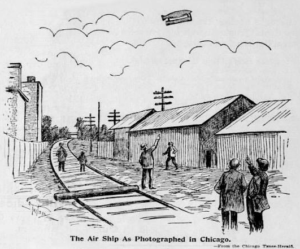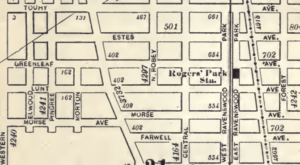A full account of how Walter McCann came to take two photographs of the mysterious airship appeared in the Chicago Times-Herald on Monday, April 12, 1897. The text of that article is helpfully reproduced in a Tripod website (from 2006) and on Patrick Gross’s website. The second (much better) photograph itself was reproduced by one of the Times-Herald’s etchers (pen and ink artist), who tried to make as good a copy as he could for printing on the front page.
But who was Walter McCann, and might a print of his original photograph (which he didn’t want to sell the negative of to any newspaper) still be in existence?
Walter McCann’s newsstand
The address of McCann’s newsstand was described in the article as “on Greenleaf Avenue”, “near the Northwestern Railway tracks”: according to a list the Chicago Eagle printed every month or so, it was 4340 E. Ravenswood Park. He lived in “Rogers Park”, and (in 1897) had a son, who had “won a camera not long ago in a contest for getting subscribers to a paper”. Nowadays, the shop on the corner of N. Ravenswood Avenue and W. Greenleaf Avenue in Rogers Park (and still right next to the railway line, though that is now elevated) is “Bark Place” (a pet daycare centre).
McCann saw the strange object “coming from the south” at about 5.30am, went inside to get his son’s camera, then “ran to Greenleaf Avenue and Market Street”. A quick look at Tillotson’s pocket map and street map of Chicago for 1900 reveals that Market Street was the old name for E. Ravenswood Park. Additionally, McCann’s newsstand appears to have been right next to where Rogers’ Park Station was.
Hence I think we can almost exactly place where the photograph of the airship was taken. I believe the the row of connected dots down the next road East marks the row of overhead cables (electricity poles? telephone poles?) that appear in the background in the image. Though I must confess that I don’t quite understand why the railway tracks in the image appear to curve off to the right when the railway tracks on the pocket map around Rogers’ Park Station appear to be perfectly straight.
Walter R McCann’s family tree
Familysearch.org suggests a Walter Raymond McCann, which (though not a 100% certain match) does seem pretty good. A quick spin round myheritage.com (where I still have a couple of months of subscription left) and familysearch.org yielded a quick family tree (though I’m less sure about the section in italics):
- Born 17 April 1860 (Paris, Bourbon KY) to Charles McCann and Harriet Current (one of six siblings)
- 1900 living in Chicago, Cook IL
- Died 21 October 1928 (Chicago, Cook IL)
- 8 May 1884 married Hannah Theodora Wright (1864-1959) in Toledo, Lucas OH
- William Ray McCann (1885-1974)
- 11 Jan 1913 married Mildred Olive Bates, Ancon, Panama Canal Zone
- Frank Bates McCann (1915-2003)
- 10 Dec 1938 married Virginia Elliott Newcomb (1915-1991), Hilton, Monroe NY
- Walter Ray McCann (1916-1997)
- 21 Sep 1945 married Katharine Duvall James (1909-1996), Allegheny PA
- Patrick Keith McCann (1950-2002)
- 19 May 1978 married Debra R Reel, in San Joaquin CA
- Patrick Keith McCann (1950-2002)
- 21 Sep 1945 married Katharine Duvall James (1909-1996), Allegheny PA
- Adriana McCann (1921-2003)
- Frank Bates McCann (1915-2003)
- 11 Jan 1913 married Mildred Olive Bates, Ancon, Panama Canal Zone
- Robert Lee McCann (1887-1976)
- 3 Jan 1907 married Evelyn Thompson (1888-1948)
- Florence Evelyn McCann (1908-2006)
- Married George John Kruchten (1902-1990)
- Robert Kruchten
- Married Marian
- Robert
- Married Laurie
- Patrick
- Married Amy
- Glenn
- Married Alison
- Robert
- Married Marian
- Robert Kruchten
- Married George John Kruchten (1902-1990)
- Walter Lee McCann (1911-1967)
- Married Violet
- John
- James
- Arlene
- Catherine
- Married Violet
- Jeanette Ellen McCann (1923-2000)
- Married Philip H Horwitz (1920-2005)
- Florence Evelyn McCann (1908-2006)
- 3 Jan 1907 married Evelyn Thompson (1888-1948)
- William Ray McCann (1885-1974)
Doubtless Walter McCann had many more descendants not included here. I wonder if one or more of them have online family trees, and a family memory of the two day period in April 1897 when Walter McCann and his son’s camera were the toast of Rogers Park?


Lots of airship “hysteria” in 1897
Perhaps this pic [hoax airship?] is a piece of the puzzle
https://www.pediment.com/blogs/news/54130693-april-16-1897-mystery-airship-lands-in-waterloo
The key/legend for the city map is on p.vii.
The print isn’t clear enough to be sure either that the dot-and-line uses a doubled line (in which case it’s to be read as electric lines for what I’d call a tram or an electric train, or instead single lines – in which case, according to that key, it’s meant for the cable-car’s cables.
In either case, it describes a public transport system – which is why that line runs down the middle of the street, as ilight poles rarely do.
Don’t get your hopes up on this one. If a photo still exists, it will almost certainly prove a disappointment.
Date and time:
The Chicago Times-Herald article was published 12 April 1897 and states the photograph was taken ‘at 5:30 yesterday morning’. This is coincidently the day of the week and time when there would be the fewest witnesses.
The camera:
The photographer states: ‘My boy won a camera not long ago in a contest for getting subscribers to a paper.’ He also mentions that the camera took photographic plates (not film) and that it produced negatives (as expected). A camera awarded in a contest for boys would surely be an amateur camera, something along the lines of this one: Columbia Optical Co., Pecto 1 http://licm.org.uk/livingImage/Columbia_Pecto_1.html.
The photographic plate sizes would be of good size– the Pecto camera’s plates measured 3.25 x 4.25 inches (8 x 11 cm). Even with the grainier film emulsions of 1897, the plates could still record considerable detail.
How likely is it that McCann could produce a clear photo of an object in the sky at 5:30 AM on 11 April 1897? This is three weeks after the spring equinox, and sunlight hits airborne objects before the ground is illuminated. Assuming good weather, the lighting should be adequate. The Times-Herald indicates clouds. Under a cloud cover, the lighting would be questionable.
Lens quality, unknown here, would be a major issue. We have some contemporary photos (1899 to 1900) taken with an amateur camera that show detail comparable to 35mm slides taken with good SLR cameras. But is it likely that a camera would have such a good lens?
Film speed, f stop, and exposure time– Film speeds were not standardized until decades later, so estimating it for the 1890s is iffy. That much said, ISO equivalent would be somewhere between 5 and 12, incredibly slow compared to the last generation of film. Aperture settings on the Pecto 1 ranged from f/18 and the smallest stop is f/38, and there were two shutter speeds: 1/40th second or timed. This would be typical of amateur cameras for the day. A rough estimate of McCann’s exposure time would be 1 to 5 seconds. McCann doesn’t mention whether he used a tripod, but he would have needed one.
Focal length– Amateur cameras of the day used medium to wide angle lenses– a 35mm equivalent of somewhere between 50 to 35mm lenses. This is significant. A distant object could not be recorded in much detail. Also given a long exposure and a moving object, whatever McCann photographed is likely to be blurred.
If conditions were good, McCann could have produced a photograph on the date and time he claimed, but it is unlikely to show the ‘airship’ as anything more than a blur.
Trick photography:
The artist and the etcher at the Times-Herald both attest to the genuineness of the photo, but their technical explanations do not exclude obvious methods of fakery, like double exposures or a model on a thread. McCann talks naively about using his son’s camera, but he has a darkroom.
The drawing:
The illustration that appears in the Chicago Times-Herald (as reproduced on this page) is made from a pen and ink drawing. Mr. Pelling wonders why the map shows a straight rail line while the illustration shows a curve. The obvious answer is that the drawing is not based on a photograph of the Northwestern Railway taken at 5:30am 11 April 1897.
By coincidence, 30 years ago we lived a few km north of Rogers Park and have ridden the Northwestern line quite a few times. It is the mainline between Chicago and Milwaukee, and it carries both passenger and freight trains. It is inconceivable the track would have been blocked by a log, as is shown in the drawing. By the 1890s the line would almost surely have had a double track, and it may well have been elevated, as it is today.
125 years ago, news illustrations were not necessarily regarded as factual, but rather as a kind of page decoration. Also, newspapers commonly published fabulous stories as a means of attracting circulation. (Both conventions seem to have returned with the internet.)
We also wonder at the crude technical quality of the illustration, as compared to the one published the same year: https://www.ebay.com/itm/204071029915 It appears like the ‘airship’ drawing was made in an hour or so by someone with the skill of a second year art student.
According to the Times-Herald report, an indefinite number saw the airship on that Sunday, and great crowds saw its light in the sky that night. One wonders if any other of the Chicago dailies reported on the incident.
We’ll take a guess at what really happened. McCann stated, ‘I refused an offer from a Chicago paper for the negatives.’ This much is true– the paper was the Chicago Times-Herald, but the reporter believed the photos were fraudulent. Irate at being bothered on a Sunday, he thought, ‘I’ll show McCann!’ He roused an apprentice from the production room make the drawing (we’ve been in similar positions ourselves), got the story out in Monday edition, and had a good laugh at McCann’s expense.
PS> We wonder who came up with the idea for the log on the track. The Times-Herald must have been laughing over that for quite a while.
LeifFraNorden: if you have followed Cipher Mysteries at all, you’ll know that the first thing I look for with every historical mystery is better evidence. So… that’s what I’m doing here, I’m not sure I’m anywhere close to coming to any kind of conclusion with this yet.
@ Nick
This all reminds me of the Westall ’66 UFO sighting! It’s probably a cold war story and its happened down the road from Springvale!!
https://www.onlymelbourne.com.au/ufo-westall-april-6-1966
https://en.wikipedia.org/wiki/Westall_UFO
https://tv.apple.com/au/movie/westall-66—a-suburban-ufo-mystery/umc.cmc.3vghztzv1rdo1u25wkm1c2u9b
Dear Mr. Pelling:
If a photo emerges, it will prove interesting and have genuine historical value. We are impressed with your ability to follow any lead, which is what a good gumshoe does. And as our wife frequently reminds us, we have been wrong before.
Still, after noticing the (presumably brown) log on the tracks, it’s hard not to see irony in lines like: ‘ “That’s right,” came a popular chorus of suburbanites near the counter, “McCann is all right.” ‘
An aside: the drawing reminds us of Walter Wellman’s 1910 airship ‘America’.